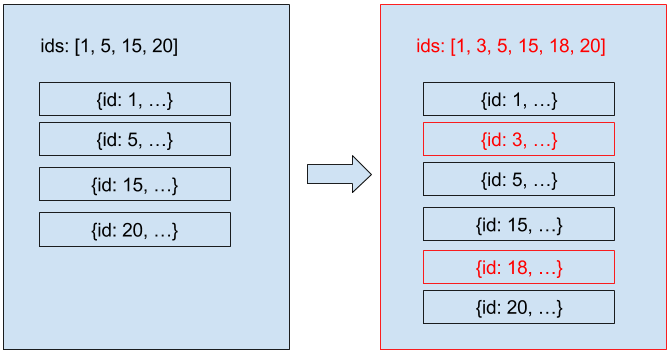@m6web/normalizer
JS Data normalizer used at Bedrock Streaming in our React frontend apps. Mainly designed and produced by @flepretre
Installation
yarn add -E @m6web/normalizernpm install @m6web/normalizerMuch of application data is presented in the form of a list of entities. In general, it is assumed that these entities never change, which is usually the case.
During navigation, the application will retrieve new lists of entities. Among these new lists, some entities are already known. In order to avoid making useless returns, we have introduced the normalizer. Its role is to normalize the list of elements and not to replace the elements already known in our reducers. In other words, the normalizer allows us to ensure the immutability of our lists of entities while deleting the rerendering of elements already present in the page.
Architecture of a list of elements
The trick to avoid resending all the elements of a list is to store the list in two parts.
- the list of ids of the elements of the list, sorted in the display order
- an index containing all the elements, indexed by their id.
This data structure (plus the respect of immutability in the store) allows us to do two things. First, it is easy to know if the list display needs to be refreshed. If the list of ids has changed, the display must be refreshed, otherwise we do nothing. Secondly, it is easy to know if an item needs to be refreshed. If the object is different, then its display must be updated, otherwise nothing is done.
Here, if we use PureComponents, only red elements will trigger rerender.
Use normalize
Reducer
import { GET_ELEMENTS } from "./element.actions";
import Normalizer from "@m6web/normalizer";
export const initialState = {
elementsById: {}, // Index of elements
elementIds: [] // List of ids
};
// Init of normalizer
const normalizer = new Normalizer("elementIds", "elementsById");
export default (state = initialState, action) => {
switch (action.type) {
case GET_ELEMENTS: {
return normalizer.set(state, action.data, action.serviceCode);
}
default: {
return state;
}
}
};- The
elementIdsvariable contains the current list of elements to display - The
elementsByIdvariable contains all the elements already retrieved, indexed by their id
Components
import React, { PureComponent } from "react";
import { connect } from "react-redux";
// Element
class Element extends PureComponent {
render() {
const { element } = this.props;
return <li key={element.id}>{element.name}</li>;
}
}
// List
const List = ({ elementsById, elementIds }) => (
<ul>
{elementIds.map(id => (
<Element element={elementsById[id]} />
))}
</ul>
);
// Connector
const mapStateToProps = ({ elements: { elementsById, elementIds } }) => ({
elementsById,
elementIds
});
export default connect(mapStateToProps)(List);The element benefits from the shouldComponentUpdate of the PureComponent which does a shallowEquals on its props.
The list is connected, so it benefits from the pure status of the connect of react-redux.
Advanced uses
The third parameter of the normalizer constructor is the index key. By default, it is 'id'.
The append method of the normalizer allows to add the ids of new elements to the list of ids.
In other words, the ids of the elements present in the list of ids are not deleted contrary to the set method.
The elements already present in the list of ids are ignored.
The append and set methods accept a second parameter. The latter allows to specify a path for the storage of ids.
It is possible to define a method via the shouldElementBeUpdated() function, which determines whether or not an element should be updated.
Example:
const programByFolderNormalizer = new Normalizer(
"programIdByFolder",
"simpleProgramsById"
).shouldElementBeUpdated(
(element, newElement) =>
element.parent_context.highlighted !== newElement.parent_context.highlighted
);




